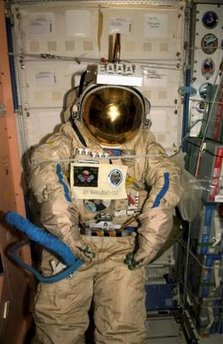CAPE CANAVERAL, Fla. - Here on Earth we get rid of our old clothes by dropping them off at the Salvation Army. But what do astronauts at the international space station do?
Friday, they will stuff an old spacesuit with discarded clothes and a radio transmitter and toss it out the door. Complete with helmet and gloves, off it should float like a lost soul in space.
The transmitter will send recorded messages in six languages to amateur radio operators — known as hams — before eventually re-entering Earth's atmosphere and burning up.
The stunt will precede a six-hour spacewalk by Russian flight engineer Valery Tokarev and U.S. commander Bill McArthur to perform maintenance and photography tasks.
The project, known as SuitSat-1, was the brainchild of a Russian ham radio operator. It will send several words in code for schoolchildren listening on the ground. Radio operators will be able to pick up the messages by tuning into FM frequency 145.990 MHz.
Along with the radio transmitter, it also will have internal sensors to monitor temperature and battery power. As the empty suit floats along, it will transmit its telemetry — temperature, battery power and time it has been in space — to the ground.
On a NASA Web site, students and others can track the spacesuit's location. The suit is expected to pass once or twice a day in the U.S., between midnight and 4 a.m., according to NASA.
"We expect the ham radio operators on the ground to be able to receive the suit signal for several days," said Kwatsi Alibaruho, flight director for the spacewalk at NASA's Johnson Space Center in Houston.This image provided by NASA shows International Space Station, an old Russian Orlan spacesuit in the Unity node of the Space Station Jan. 24, 2006. The suit will be released by hand from the space station during a spacewalk Friday Feb. 3, 2006. Outfitted with a special radio transmitter and other gear, the spacesuit comprises a Russian experiment called SuitSat. It will fly free from the station as a satellite in orbit for several weeks of scientific research and radio tracking, including communications by amateur radio operators. Eventually, it will enter the atmosphere and be destroyed. (AP Photo/NASA)
During Friday's spacewalk, Tokarev and McArthur are scheduled to cover a wide swath of the 240-foot-wide, 140-foot-long floating station as they take on several chores. It will be the fourth spacewalk for McArthur and the second for Tokarev.
One of their chores involves taking steps to protect an important cable connected to a transporter that moves a platform holding the station's robotic arm.
A twin cable which provides power, data and video to the mobile transporter was inadvertently cut in December. Mission managers want to make sure that doesn't happen to the remaining cable. The cut cable will be repaired at a later time.
The other tasks include creating storage space, retrieving a Russian science experiment and photographing handrails, antennas and sensors to see how they have held up in space.
"By the conclusion of this (spacewalk), Bill and Valery will have traversed to the extreme ends of just about every length of the international space station, a rare feat that they are really looking forward to," said Anna Jarvis, NASA's spacewalk officer.
Friday, February 03, 2006
Students to Track Discarded Spacesuit
This is just TOO COOL! From Yahoo News:
Subscribe to:
Post Comments (Atom)



No comments:
Post a Comment